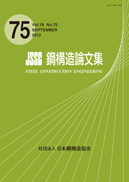All issues

Volume 19 (2012)
- Issue 76 Pages 76_1-
- Issue 75 Pages 75_1-
- Issue 74 Pages 74_1-
- Issue 73 Pages 73_1-
Volume 19, Issue 75
Displaying 1-6 of 6 articles from this issue
- |<
- <
- 1
- >
- >|
-
Xiao CHEN, Yoshito ITOH2012 Volume 19 Issue 75 Pages 75_1-75_12
Published: September 28, 2012
Released on J-STAGE: February 01, 2014
JOURNAL FREE ACCESSPatch welding is a common method to repair corrosion-damaged steel structures. This paper investigates the performance of steel pipe piles repaired by patch welding considering the effect of the existing axial compressive loads. The performance of pipe piles is evaluated by a set of finite element (FE) analysis, and the mechanism of load transfer in the repaired pipe piles is examined. A minimum patch thickness to recover the initial stiffness and the strength of the corrosion-damaged pipe piles is proposed. Some practical issues in the welding repair design are also discussed.View full abstractDownload PDF (1443K) -
Seishi TSUYAMA, Keiji UEDA, Hisaya KAMURA, Kei NAKAGAWA2012 Volume 19 Issue 75 Pages 75_13-75_25
Published: September 28, 2012
Released on J-STAGE: February 01, 2014
JOURNAL FREE ACCESS780N/mm2 Grade strength steel plates designed for earthquake-proof buildings have been developed. They provide high strength, low yield ratio, weldability and excellent toughness in welded joints. Key technology to obtain an excellent combination of mechanical properties is microstructural control of M-A (Martensite-Austenite constituent) and granular bainitic ferrite dual-phase structure through HOP (Heat-treatment On-line Process) immediately after an accelerated cooling in TMCP(Thermo-Mechanical Control Process). The developed steel plates have shown satisfactory performance for local buckling.View full abstractDownload PDF (3244K) -
Daiyu IKAWA, Keiichiro SUITA, Kenzo TAGA, Yoshikazu TANABE, Haruo TSUK ...2012 Volume 19 Issue 75 Pages 75_27-75_39
Published: September 28, 2012
Released on J-STAGE: February 01, 2014
JOURNAL FREE ACCESSThis paper presents the results of full-scale loading tests of beam-to-column subassmblages strengthened by TF (Thick-Flange) connection. TF connection is a moment frame connection with the thickness of the beam flange increased near the connection region to prevent fracture of the welded moment connection and effective to improve workability and quality of the welding. From test results, TF connection successfully avoid fracture initiated from welds and exhibited sufficient deformation capacity. The design method of the tapered thick flange is proposed to prevent a crack at the toe of the weld access hole and to keep the plastic region of the beam away form the welds.View full abstractDownload PDF (3997K) -
Hiroshi ZUI, Kentaro TANAKA, Masahide MATSUMURA, Masahiko YOSHIDA, Dai ...2012 Volume 19 Issue 75 Pages 75_41-75_53
Published: September 28, 2012
Released on J-STAGE: February 01, 2014
JOURNAL FREE ACCESSThis paper proposes a design method of steel bellows as seismic control devices for girder bridges on temperature girder deformations. Steel bellows are connected between girders and abutments in order to reduce the damage of superstructures and substructures. Local plastic strains of bellows are permitted due to temperature expansion and contraction of girders considering fatigue strength. This paper also proposes an estimation method of seismic maximum displacement of steel bellows using nonlinear response spectrum. The size of bellows can be designed based on the proposed methods and the maximum displacements are estimated using nonlinear response spectrum. The estimated values are compared with calculated values by FEM and the estimated values agree fairly well with those of the non-linear time history analyses.View full abstractDownload PDF (2052K) -
Jun MURAKOSHI, Naoki YANADORI, Toshiki ISHIZAWA, Naoki TOYAMA, Takumi ...2012 Volume 19 Issue 75 Pages 75_55-75_65
Published: September 28, 2012
Released on J-STAGE: February 01, 2014
JOURNAL FREE ACCESSIn this paper, effect of thickness of deck plate on fatigue durability of orthotropic steel deck is discussed with wheel running tests. Test specimen of this research has combinations of 16/19mm thickness deck plates and 6/8mm thickness U-shaped ribs. Wheel running tests with 4 million times loading were conducted on each part of the deck. Finite element analyses were also conducted in order to clarify effect of thickness of deck plate on local stress at weld joints connecting deck plate and U-shaped rib. It was clarified that local stresses at weld root become smaller and the crack propagation tends to slow with increase of deck plate.View full abstractDownload PDF (5469K)
-
Kuniaki MINAMI, Chitoshi MIKI, Hideki YOKOYAMA2012 Volume 19 Issue 75 Pages 75_67-75_77
Published: September 28, 2012
Released on J-STAGE: February 01, 2014
JOURNAL FREE ACCESSRecently, many kinds of weathering steel were widely used in steel bridges. 1% and 3% Ni-advanced weathering steel are new types of weathering steel. It was considered that the quality of these steel have been remarkably improved. However, such improvement had not been quantitatively clarified. Therefore, in the past, we had investigated 753 of 1% Ni-advanced weathering steel on the basis of the mill sheet in order to clarify their quality, and these steel mechanical properties had been shown. In this paper, we investigated the 764 of 3% Ni-advanced weathering steel on the basis of the mill sheet. Investigated items were tensile strength, yield strength, charpy-absorbed-energy, elongation and yield ratio. We also discussed how much of these quantities were improved, comparing with the conventional weathering steel data.View full abstractDownload PDF (1082K)
- |<
- <
- 1
- >
- >|